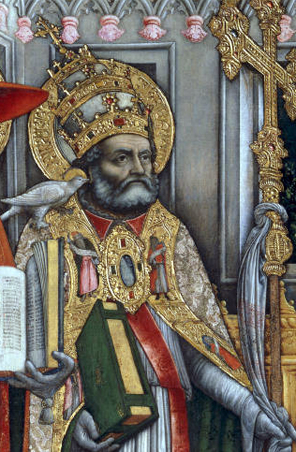The Spread of Christianity in Britain
Find out how the Benedictines were involved in helping the spread of Christianity in England.

Detail of a fifteenth century painting of Gregory I, the pope who sent St Augustine to England to spread Christianity.

A twelfth-century wall-painting in the Galilee Chapel at Durham Cathedral depicting St Oswald.
Pope Gregory's Delegation
In 597, Pope Gregory sent a delegation led by a Benedictine monk, St Augustine, to Britain, to spread Christianity in what was essentially a pagan land.
The King of Kent and his Christian Wife
Augustine and his companions received permission by the King of Kent, Æthelberht, to reside in his kingdom and were given a place to live in his principle city, Canterbury. Ætherlberht’s willingness to accept this group of monks was probably due to the fact that his wife was a Christian from the royal house in Paris, who worshipped – along with a priest, Bishop Liudhard – at a small Roman-built church outside the city walls.
The Conversion of Ætherlberht
Ætherlberht himself converted to Christianity a few years later, and this led to numerous other conversions as well. The fact that the Christian community was expanding, and included the king itself, had a significant impact. An old Roman church was restored by the monks, and became the first true Cathedral at Canterbury.
But when Ætherlberht died in 616, Christianity had not expanded much, and it looked as if it would not catch on.
The Conversion of the Northumbrian Court
It was only in 625, when Ætherlberht’s daughter married Edwin, the king of Northumbria, and moved north, that things began to change. She took with her a monk, who, two years later, succeeded in converting the king, his entourage, and other members of the community.
King Oswald and the Monks of Lindisfarne
Oswald’s Rise to Power
Oswald came to power as King of Northumbria in 634 having overthrown a pagan king, who came to rule for just one year, after killing the former King Edwin, Oswald’s uncle.
Celtic Monks and Monastic Beginnings at Lindisfarne
Oswald was a Christian who had been converted under Celtic monks from the island of Iona off the west coast of Scotland. Upon becoming king, he sent for a bishop from Iona – which led to the move of the Bishop Aidan and a small community of monks to the island of Lindisfarne, off the coast of Northumbria in 635.
In choosing Lindisfarne, they were following the Celtic tradition of travelling around the country, preaching, and – totally unlike the Roman tradition – neither living in urban areas nor building cathedrals. Oswald gave Aidan his blessing to preach, and many people converted during his reign.
Oswald’s Death and Sainthood
Oswald established himself as overlord of most of England, but in 642, was killed in a battle by the pagan king of Mercia, who had Oswald’s body dismembered. His head however, was kept and sent to Lindisfarne, where it was treated as a relic.
Bishop Aidan and the Conversion of Northumbria to Christianity
Aidan came to Lindisfarne Island in 635, after his predecessor, summoned by King Oswald of Northumbria to come and preach there, had proven unsuccessful at converting people to Christianity – finding them too set in their ways. Aidan, accompanied by 12 monks, set out to explain Christianity simply and with empathy to people he met travelling along various roads in Northumbria.
At the beginning, Aidan knew Irish but no English, and it was often the King, Oswald, that acted as a translator for the Bishop, presumably in court.
By the time of his death in 651, Aidan had had a major impact, having led to the establishment of many new monasteries and churches, and encouraged more monks to come to Northumbria from Iona.
More details about Aidan’s life.

